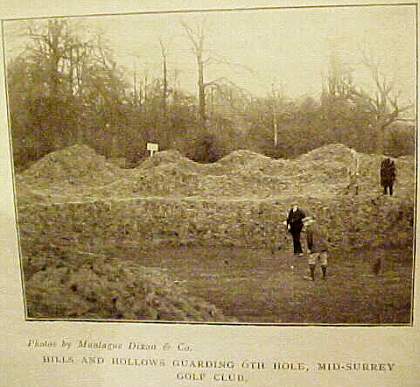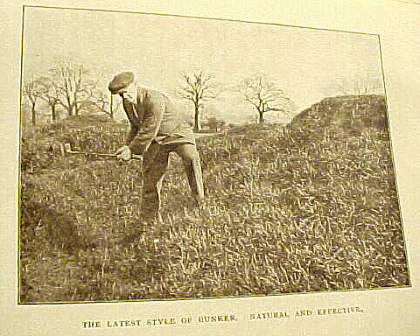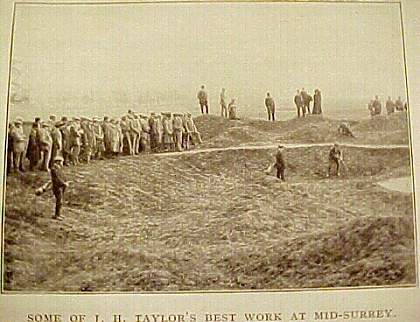In Praise of The Ralph Miller Library
by Thomas Naccarato
Life’s bitter twists of fate has some shining if not monumental moments.
In the closing minutes of the Ralph Miller Golf Library, its fate, in the throes of death, I can truely say that I was in a extreme state of shock. It was just as if I was visiting a close friend or relative dying from some horrible disease as they were being ripped away, and being taken out of my life.
The Ralph Miller Golf Library has given me and countless others, great joy over the years, and in times when I was just looking for escape from the rigors of the real world. It was a haven of excess for a purist. Having this grotto to the game of golf less then fifteen minutes from my home was an even more spoiling factor in its closing.
While I busily scanned and photocopied as much as I could in the closing minutes, Diane Shackelford was looking in on some of the cases of books that would soon be packaged up and sent away to some dark and desolate storage, clearly, not a place where such a creditable and vast tribute of the game should end up. In one of the beautifully mahogany book cabinets which I had spent so many countless hours, she produced a book that I had neither heard of nor seen in my entire years of frequenting the library.
Being that I have this great love of sand hazards because of their natural ability to depict a golf landscape, I was especially intrigued by the fact that this book was written by the brother of famed golf great J. H. Taylor.
Josh Taylor had asked his brother to put in print his thoughts on the history of the sand hazard, which is entitiled, ‘The Evolution of the Bunker.’ The book itself, ‘The Art of Golf,’ looks to be another timeless classic and only assures me of just how much valuable knowledge that is contained in the Ralph Miller collection and how it should not be broken-up for sale to the highest bidder.
While I literally had what was maybe fifteen minutes of time left in the library’s history, I took out my digitial camera and with the help of Diane, managed to shoot every page and picture in Taylor’s chapter, hence, the look of the photos and their weird angles and shadows.
I dedicate this ‘In My Opinion’ by J.H. Taylor to the hard efforts of Saudra Sheffer and Marge Dewey, formerly of the once great Ralph Miller Golf Library. For me, they are two of Golf’s Most Beloved Friends, if not Unsung Heroes. Ironically, neither of them have ever once stepped foot on a course as a player or particpant, yet, both of them have more knowledge of the game, it’s history and it’s traditions then most golf professionals and their avid peers.
Also not to be forgotten is the memories of Ralph Miller and Bill & Jean Bryant who provided this collection and realized its worth by keeping it open to the public so we could all benefit from it’s holdings and its memories to the game .
Long live ‘The Ralph.’
The Evolution of the Bunker by J. H. Taylor (an excerpt from his book The Art of Golf)
I have been asked by my brother to write a chapter on the evolution of the Bunker, and although I approach the subject with all humility, I hope from the experience I have gained through some thirty years’ acquaintance with the game, during which I have seen many changes, the chapter will prove interesting to those golfers who may chance to pick up this book.
My first knowledge of bunkers was gained, as most golfers are probably aware, on the links of Royal North Devon Club at Westward Ho, where I served an apprenticeship first as a caddie, and later as a groundsman. In those early days the made bunker was unknown.
On such a light and sandy soil as the Westward Ho! links are situated, it took little for a bunker to makes its appearance after a dozen players had used the old-fashion lofting-irons. The turf was easily cut, and once this protection was gone, the continual tramping soon broadened the scar until it spread some yards around. After the start the work went merrily. The north-west wind, the prevailing wind in that part of the country, simply scooped the sand away, and where some three months before had been divot-marked patch of turf now appeared an irregular hollow of sand gradually being widened by the caving in of the sides under the pressure of the players’ and caddies’ feet.
One could see the bunkers grow larger and larger day by day, until means had been had to be taken to keep them within reasonable bounds. This was accomplished by disused railway sleepers or other such timber being driven into the sand, forming a background upon which was nailed a wide pieces of board the whole depth of the bank. The space between the boards and the bank was filled-in and turfed over level with the surrounding country, but such is the aggravating nature of the wind, that sooner had one bunker been properly harnessed then it immediately started to make another. However, there is a limit to the bunker-making propensities of the north-west wind even at Westward Ho! and although at times it would playfully scoop up sand from a bunker and scatter it for yards around and several inches deep, it did not necessitate a deal of labour to throw it back again to it’s original home. Thus were bunkers made in the days long past-made by the actual play of the golfer, the tramp and joyous slide down the bank by the caddie, and the restless never ending blow of the north-easter. In these days there is never an outcry as to the position of the bunker. If a bunker happened to be in a particular spot, even if it were directly in the way of access to the hole, there was no agitation started to have filled in. It was an accepted in a spirit of meek philosophy as an act of Providence, and it was circumvented as best it could. There was no calculated cut-and-dried methods in those days.
Stern Nature was tackled with a bold frontal attack, and if the attack failed there was great glory in the failure as in a successful assault. The way to the hole was where the bunkers were not, and these strategic methods made the player of acute perception, and rendered him the Napoleon and master of the most intricate of holes. This was before the game was introduced into the interior, before, in fact, a golf was played in England at more than half a dozen places, but when, in it’s joyous march it captivated the sound of the booming of the surf on an open beach, or the shrill of the March gale, it was found necessary to make, what nature had provided on seaside courses, a bunker that would trap for the unwary, and source of delight to those players whose skill helped them to circumvent the alluring charms of this apparently innocent contour of the country.
The type of bunker mostly in favour on the new inland courses proved to be a bank of soil of varying height, but generally between 4 and 5 feet, stretched right across the line of play, the front of which-that is, the side nearest the player-being hollowed out for several yards and filled in with sand. This bunker, which was popularized by the late Tom Dunn, the pioneer of golf architects and immediately one of the best men at his profession in the kingdom, was adopted on practically all the hundreds of courses that sprang up, as it were, during the night. It was found that such a bunker admitted of no sneaking round the corner; over the player had to go somehow!
Two bunkers at a hole were thought sufficient when first golf started to creep about the country, one as a carry from the tee, and another guarding the whole front of the green. At long holes a third was added that had to becarried with the second shot. These cross bunkers, as they were called, were certainly not natural looking, appearing as much like walls as anything, but they were very effective. After a time it was thought that this style bunker did not meet the requirements of the general body of players.
A band of red-tied revolutionaries then took charge of the game, and the teaching a new doctorine that it was not fair that the green should be entirely guarded with a long bunker, neither was it quite the thing for man to have a hazard that would probably catch his half-topped second shot, prevailed upon a clot of existing and several clubs that were just forming to forego this style and adopt the method of punishment that they had created. This system of bunkering was to place traps on the sides of the course only. This did away with anything in a straight line between tee and hole, and in consequence there was nothing to prevent a series of topped shots from reaching the green in but one over the orthodox number. The bunkers were, made in a half-moon formation, with the two arms sticking out like a Zulu impi about to charge, to quote Sir Conan Doyle, and just as dangerous, when it caught its prey; but that was the drawback.
Unless a ball was sliced or pulled to just the right amount, the ball passed the bunker on one side or the other, and the lucky player was but little worse off than his opponent who had kept down the middle. True, he might belying in the rough, but he had no bunker to carry with his second, and could therefore afford to play up with the oft materialized hope that he could put his third near the hole. This was obviously unfair, but at the time there was thought of reverting to the cross hazard that would have rendered it impossible for this player to have comfortably reached the green in three. Had it been done, this man would have had to be content to have played his short of the cross bunker with his second, and would probably have been left with an extremely difficult long shot to reach the green in three. Then the other player would have reaped the benefit of keeping straight with his drive, for the second bunker would have had but little terrors for him and by easily getting on to the green with his long second or a very short pitch, would have been able to claim the advantage to which his drive had entitled him. This was a fault that had badly wanted eradicating, and then came the season of pots.
Pots here, pots there, shallow and deep, some hidden, some yawning like the open mouth of a deserted mine, until it looked as if a party of prospectors had been over the links hunting for gold. They were placed three parts around the green, but seldom in front, so the half-topped approach still laughed silently to itself as it trundled its way bumping on towards the hole.
After a while the pots even made their appearance in the fairway, but generally placed in such a position that the worst of bad shots was quite safe, while the good drive or second shot invariably came to rest comfortably tucked up right under the bank. The worst of this type of hazard was that they were rarely seen from the tee, and not until your caddie exclaimed with a grin, ‘Your in, sir,’ did you know that the depression with its velvet-like piece of turf at which you had so carefully aimed was lurking-place of that monster the ‘Spittoon’ as one professional unkindly called it.
This type of bunker is the one that is so much in vogue today, but quite recently there has sprang up a system that bids fair to oust it from public favor. This style of bunker which I claim conceit was of my own initiating, takes the form of irregular hills and hollows, the idea being able to copy Nature as closely as the hand of man admits. This new type was first laid down on the links of the Mid-Surrey Club, to whom I have the honour of being the resident professional. Naturally there was a certain amount of skepticism when the scheme was first mooted, but I prevailed upon the committee to allow me to try the effect on one hole.

Too much praise cannot be given Peter Lees, the club green-keeper, for the whole-hearted way in which he joined me in this work. His practical advice was of the greatest value to me and in consequence our efforts were so successful that the committee decided to do the whole course. This was tremendous undertaking, and one of that few clubs would have contemplated in cold blood, but Mid-Surrey proved equal to the occasion, and by giving Lees and myself practically free hand we started in the winter of 1911.
The humps and hollows grew apace, but in spite of the crowding of over a hundred men scarcely half the work was completed when the Spring called a halt to our labours. No time had been lost; in fact, to show how matters were rushed, we converted a big pot bunker at the first hole into a line of miniature Himalayas in one night, working by oil flares.
I should like this fact put on record, for I honestly believe such an innovation had never before taken place on a golf links. Imagine the surprise of the members who on coming onto the first tee the next morning found a line of hills to carry with their drives instead of the pot that they had so frequently jumped or run through. This whetted the appetite of the members, and consequently last winter we completed the course. Lees and I had the satisfaction of converting a flat uninteresting course into one that from the first tee to the last hole is ever changing in character. It is quite a transformation, and even I myself confident as I felt, did not expect quite such a change. It has gained for Mid-Surrey an enviable notoriety, and I must confess to a feeling of pardonable pride at having been allowed to successfully carry what was undoubtedly a new phase of golfing architecture.

The value of this system of bunkering lies in it’s powers of graduating the punishment meted out to those golfers who at times wander from the narrow, straight path. The hills and hollows can be constructed that the further the player gets off the course the worse the punishment. The punishment can be made to fit the crime, as it were, and there are few to be found who will not agree that this is as it should be. It is obviously unfair that the ball just finds its way off the course should be treated with the same severity as the ball that is half-way towards the next county.
With skillful construction the element of luck can be reduced to a minimum. The accurate player will receive that reward consistent with his superior straightness, and there will be left little scope for the individual who largely trusts to luck to help get near a hole.
On a flat course the hills, from a spectacular point of view, are of immense value. No longer needed club committees stand the chagrin of being accused of playing over the meadows. I am quite aware of the fact that it is beyond the power of the majority of clubs to work such an alteration on their courses in the short time it was taken with Mid-Surrey, the question of means being one that prohibits this, but if little is done every winter it will not take long before an alteration is effected. Each winter there is some time that could be devoted to this, preferably when nothing of greater importance requires attention, but there is often a day or so when it is extremely difficult to find work for the staff of groundmen. Take advantage of these opportunities, and you will not regret it.

I might be asked in what way this bunkering is going to affect the playing of golf, and I unhesitatingly answer that it can have beneficial results.
The doing away with the cross bunker was, in my opinion, a great mistake, and there are signs that before long the merits of this means of trapping shots will be recognized, and that we shall see a reinstatement of the old order of things.
The cross bunker of the future will be a line of hills that will look as much like the real article as possible. There will be no complaints of brick-wall like straightness, neither will there be convert sneers at the ramparts, and with the disappearance of this one point will also fade the senseless objection to a hazard that showed favour to no one.
The End







